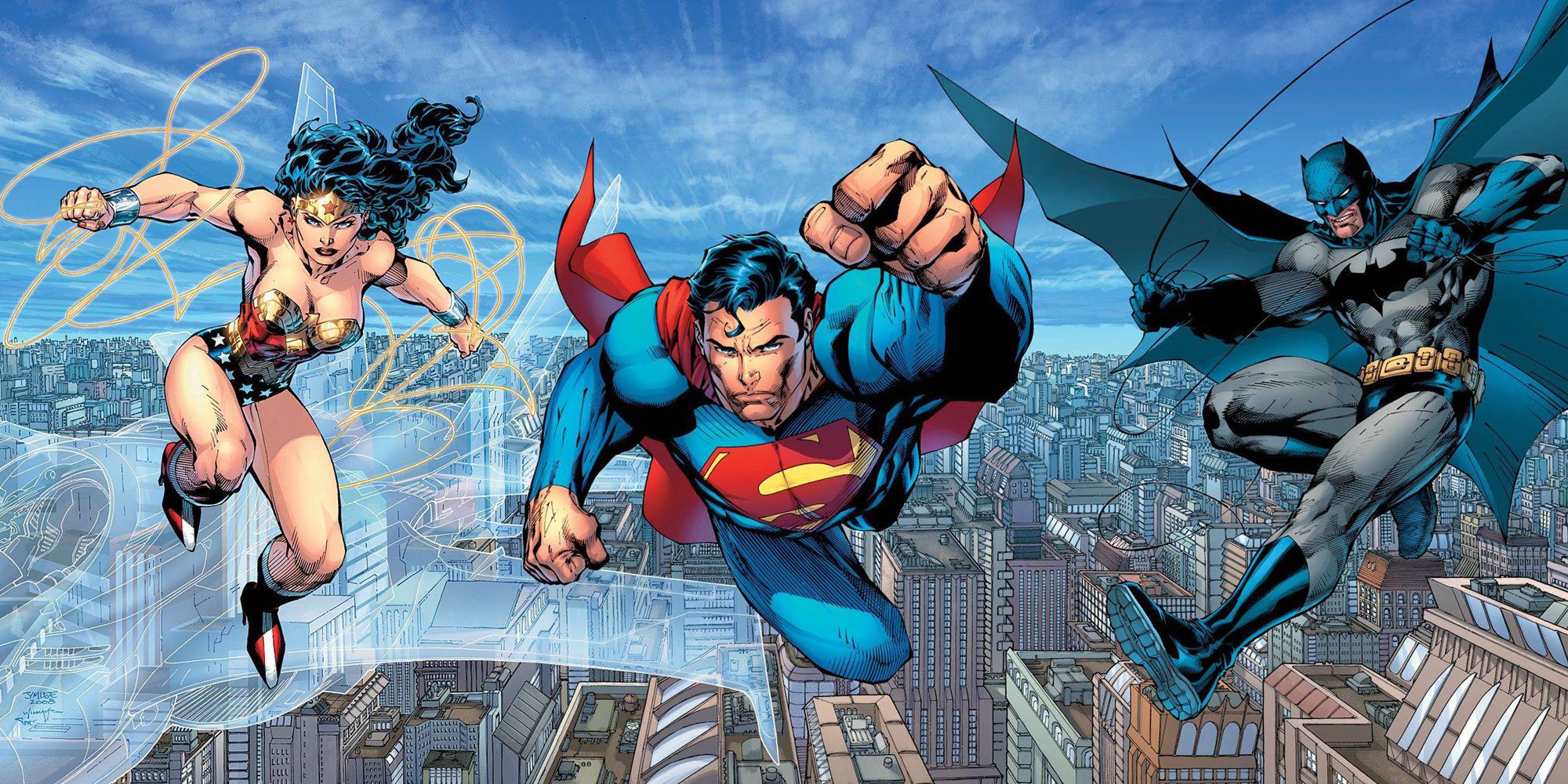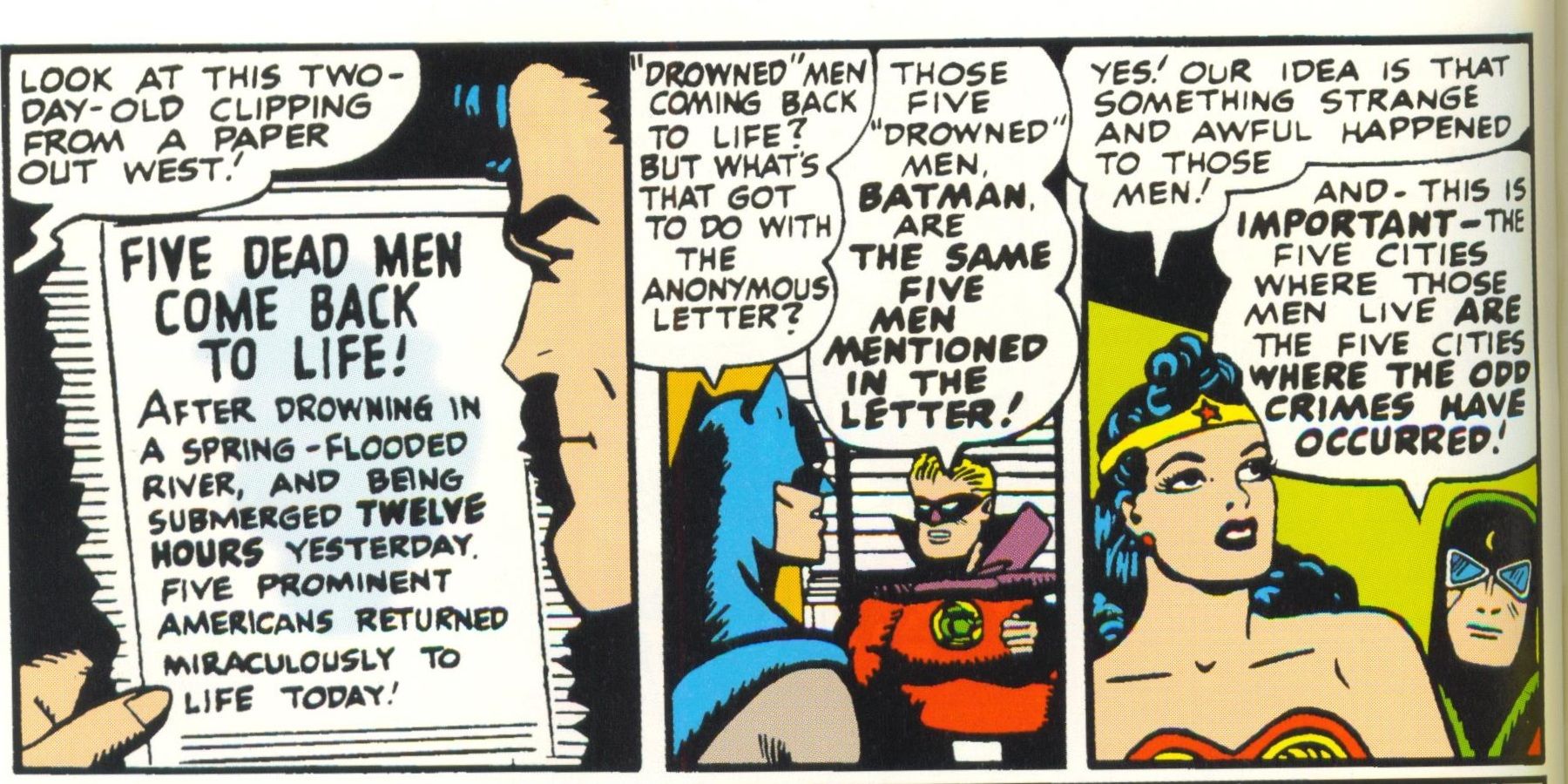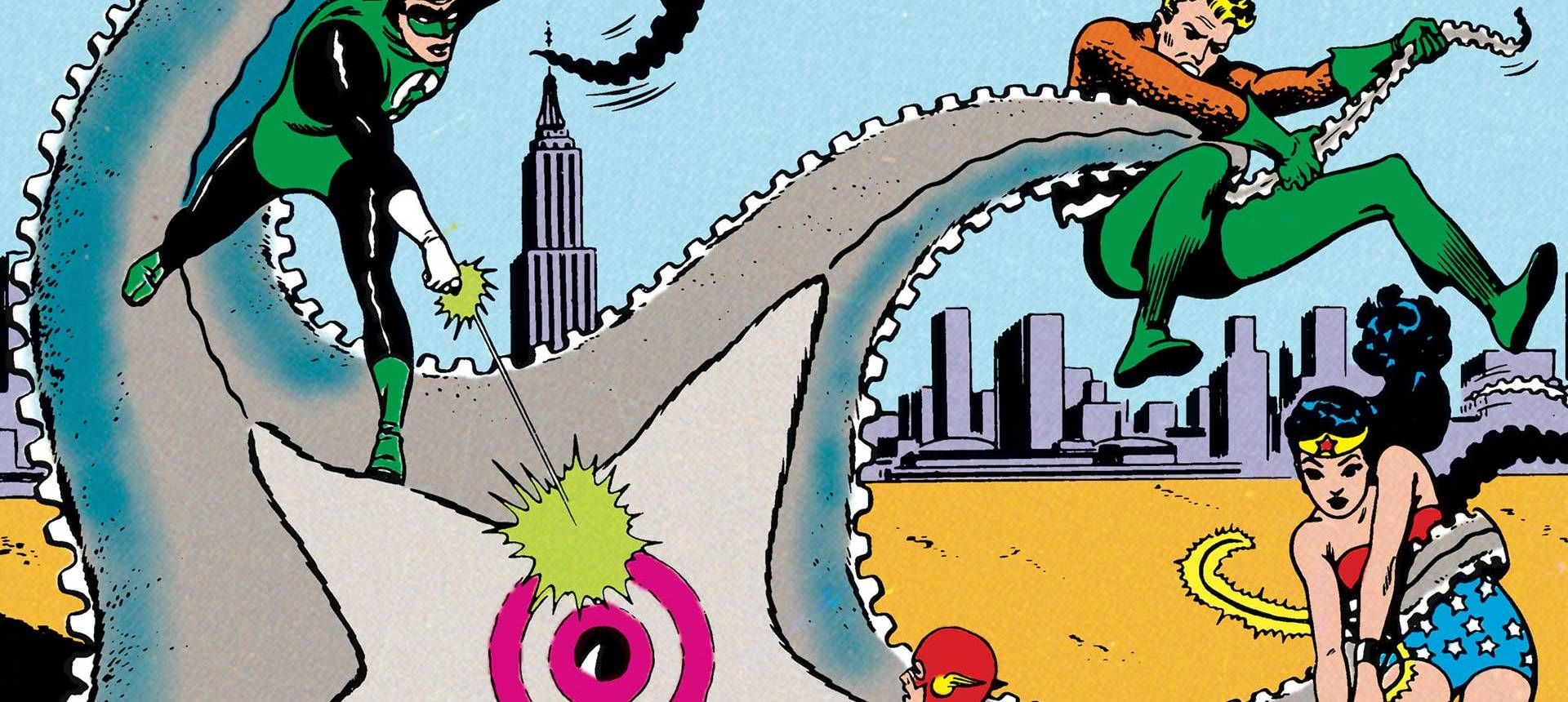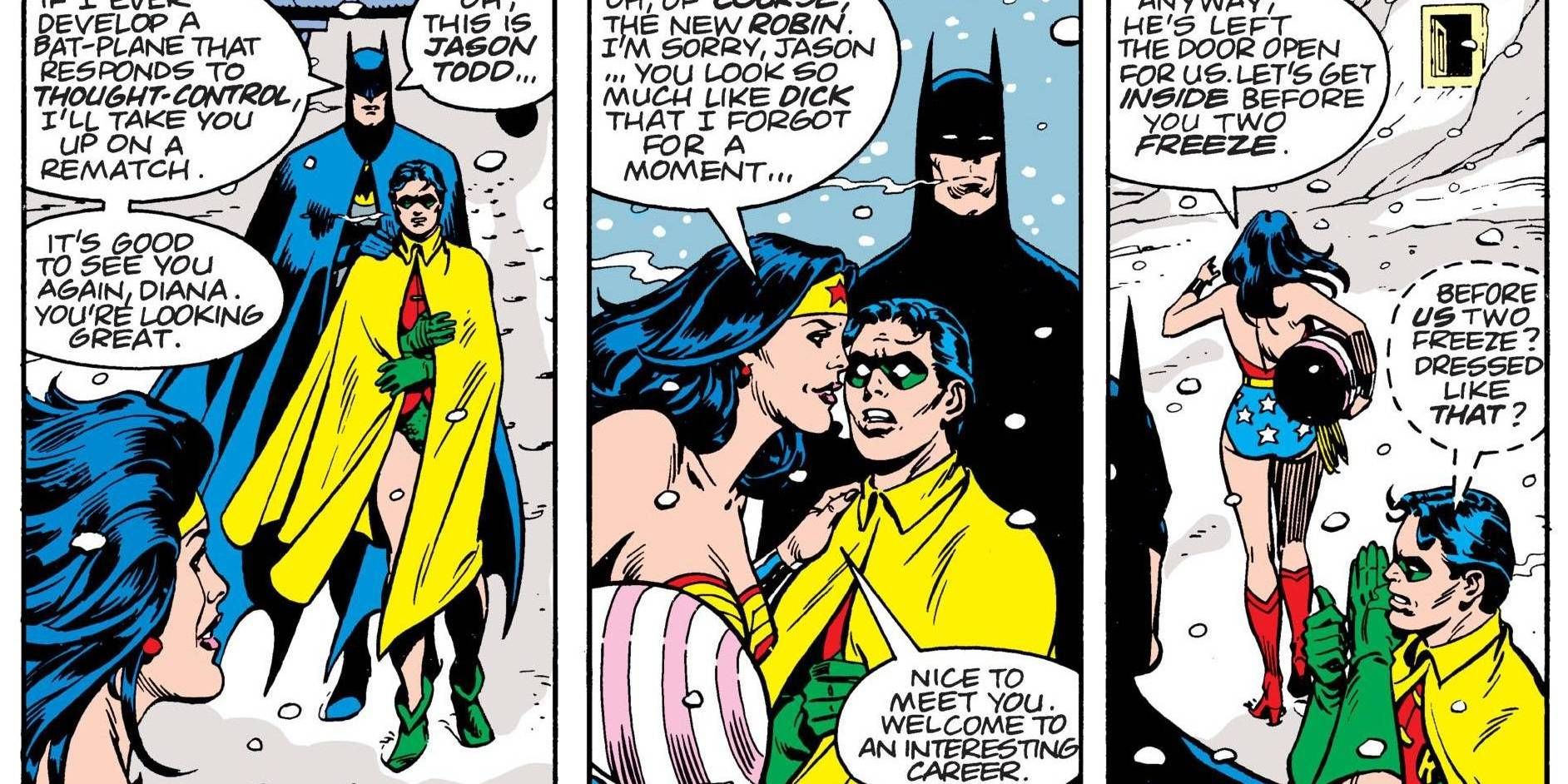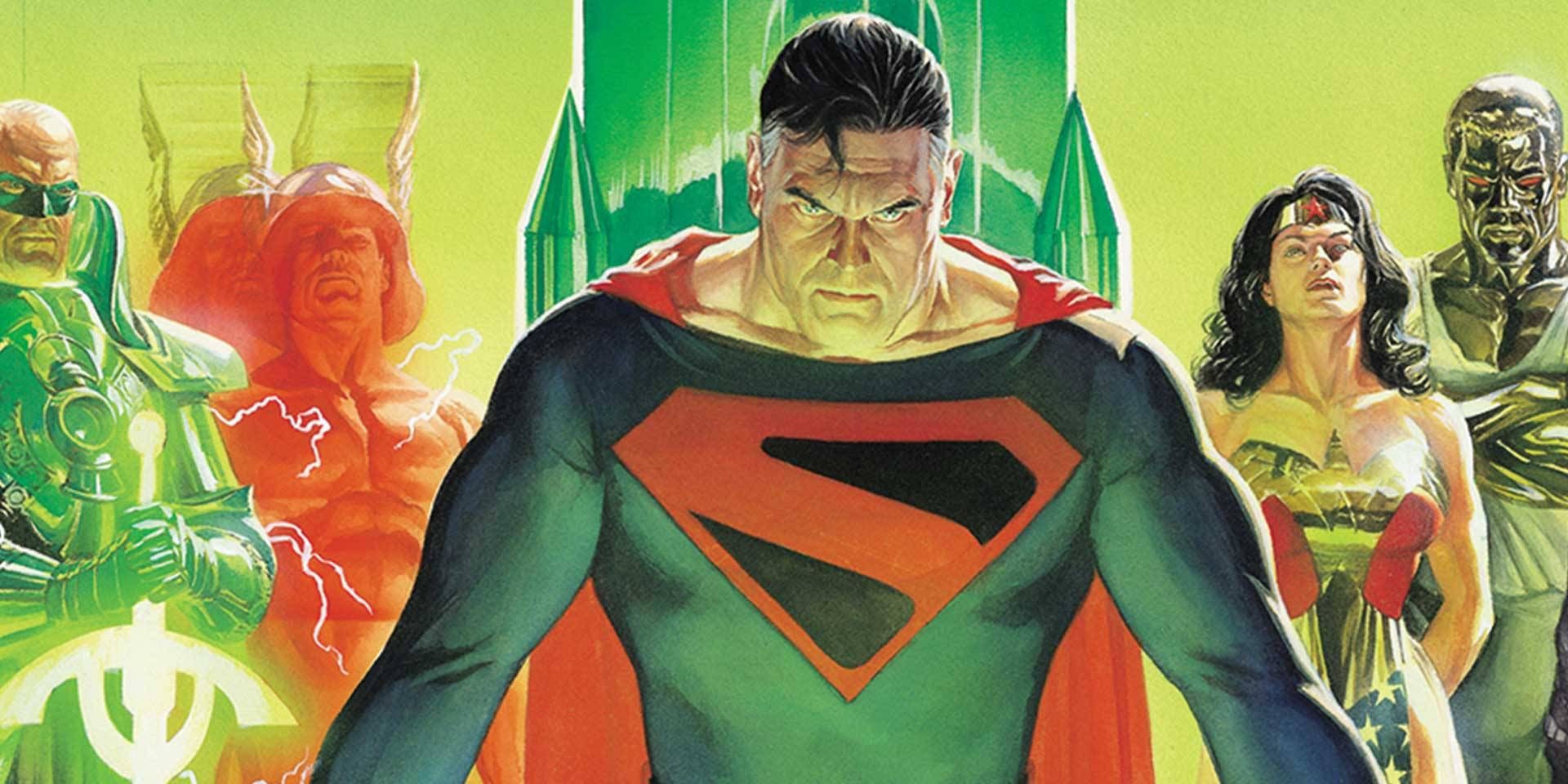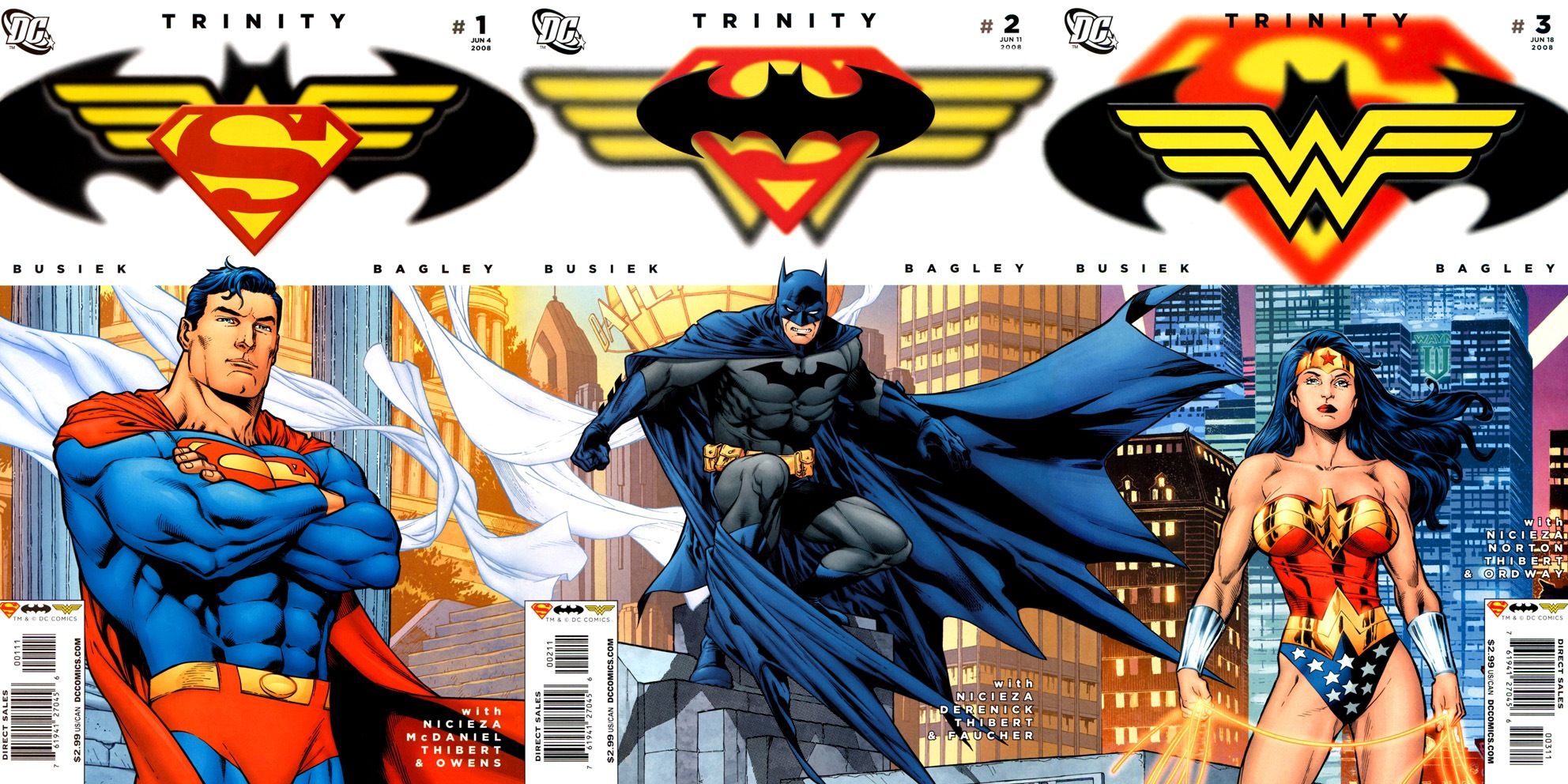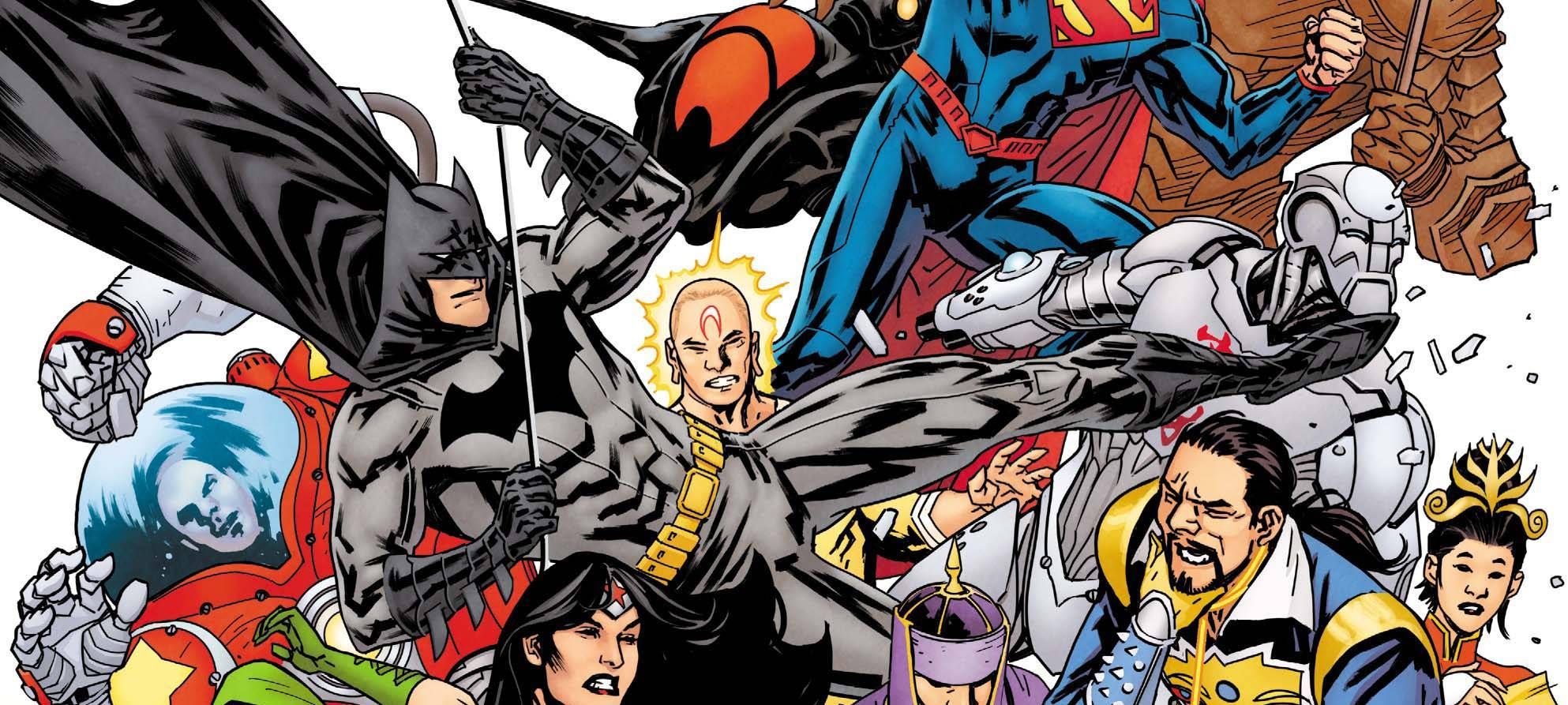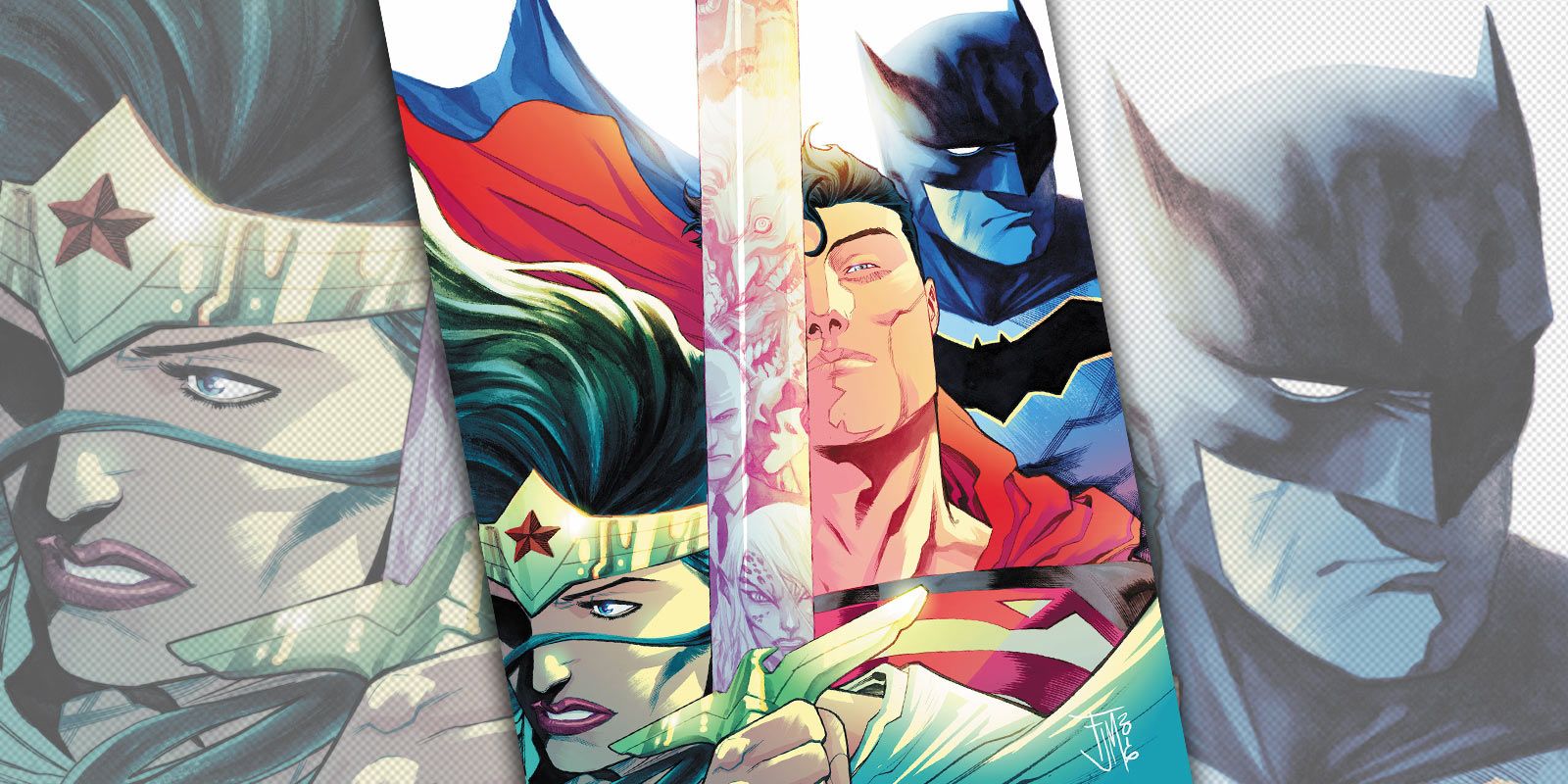Superman, Batman and Wonder Woman are DC Comics' three longest-running features. Each has been published continuously (brief hiatuses notwithstanding) since their respective introductions. However, although all three worked with the Justice Society of America, and were charter members of the Justice League of America, for most of their shared history they weren't officially part of a "trinity." Instead, the three characters formed various pairs. Superman and Batman teamed up regularly in "World's Finest Comics" from the mid-1950s through the mid-'80s, and then again in "Superman/Batman" and "Batman/Superman" starting in the early 2000s; but Superman and Wonder Woman's team-up title didn't come along until 2013, and Batman and Wonder Woman have only had a handful of team-ups.
Accordingly, the concept of a Superman/Batman/Wonder Woman trinity is a relatively recent invention which nevertheless has its roots in the Golden Age of Comics. As DC launches a new "Trinity" ongoing series from writer/artist Francis Manapul this week, we'll look at when DC's three biggest characters first got together, and why it took so long to make that stick.
The Golden Age
The three characters' first joint appearance in a comics story (or, for that matter, on a comics cover) was with the Justice Society in August-September 1947's "All-Star Comics" #36. This was well into the JSA's run, which had started in issue #3 and would go through issue #57. Of course, Wonder Woman's first appearance was in "All-Star" #8 (December 1941-January 1942), in a story separate from that issue's JSA adventure. She guest-starred with the group in issue #11 and joined the JSA officially in issue #12. Although at first she was referred to as the team's "secretary," she was a regular member of the team, missing only issue #23.
By contrast, Superman and Batman were only considered honorary members. They had made cameo appearances in issue #7 (i.e. the one before Wonder Woman debuted) but issue #36 was their only Golden Age adventure with the group. Otherwise, the three characters spent most of the Golden Age on their own.
That started to change, at least for the men, in May-June 1952's "Superman" #76. In "The Mightiest Team In The World," Clark Kent and Bruce Wayne found themselves sharing the same cabin on an ocean liner. After stumbling upon each other's secret identities (changing clothes in the dark, thinking neither will notice, as you do) they ended up catching some jewel thieves. The two characters had been appearing in separate features in "World's Finest Comics" since the early 1940s, but that turned into regular team-ups starting with July-August 1954's "WF" #71.
Meanwhile, Wonder Woman's creator William Moulton Marston and artist H.G. Peter had guided the bulk of the Amazing Amazon's adventures (including the short-lived newspaper strip) from their 1941 start until Marston's death in 1947. When Bob Kanigher took over for Marston, he steered the character away from social consciousness into a more traditional blend of fantasy and superheroics. (H.G. Peter stayed until 1958, when Ross Andru succeeded him.) Although Wonder Woman had appeared in multiple titles in the 1940s -- her own, "Sensation Comics," "Comic Cavalcade," and with the JSA in "All-Star" -- after 1951, when the final JSA story was published and "Sensation" was cancelled, she was left with only her solo book. What's more, there wasn't much in the way of a DC Universe outside of the Superman and Batman lines. Still, by surviving the end of the Golden Age, Superman, Batman and Wonder Woman were well on their way to becoming the foundation of a new superheroic era.
The Silver Age
Appropriately enough, the future Trinity's next relationship milestone came late in 1959 (cover-dated February-March 1960), when "The Brave and the Bold" #28 introduced the Justice Society's successor group. Indeed, as with the Golden Age team, Superman and Batman were listed as Justice Leaguers but were each "too busy" to help defeat Starro the Conqueror. They didn't even make the cover, which (along with Wonder Woman) sported new versions of the Flash and Green Lantern alongside Aquaman and the Martian Manhunter. Regardless, Batman was a bigger part of the story in "B&B" #29 (although Superman still didn't appear until the end) and by #30 the whole team was together.
Two main factors contributed to slow-walk the World's Finest duo into the League. First, neither Superman editor Mort Weisinger nor Batman editor Jack Schiff were particularly eager to share their A-listers with JLA editor Julius Schwartz (who also edited "Flash" and "Green Lantern"). Second, "Justice League" was seen as more of an opportunity to boost the other five heroes, because Supes and Batman apparently didn't need much help. While Batman appeared in "Detective," "World's Finest" and his own book, the Super-titles included "Action," "Superman," "World's Finest," "Superboy," "Lois Lane,""Jimmy Olsen" and "Adventure Comics."
Nevertheless, apart from her League adventures, Wonder Woman's own series didn't interact much (if at all) with the expanding superhero line. Superman guest-starred briefly in "Wonder Woman" #130 (May 1962) in a story inspired by a Justice League adventure, and as a Leaguer she went to the weddings of Aquaman and Mera and the Doom Patrol's Mento and Elasti-Girl. Outside of the JLA, though, I can't find any substantive team-ups involving her and Batman, let alone the three future Trinitarians together, until the end of the '60s. In the "Diana Prince" era, Wonder Woman guest-starred with Batman in "Brave and the Bold" issues #87 (December 1969-January 1970) and #105 (January-February 1973); and was in "Lois Lane" #93 (July 1969) with Superman. For whatever it's worth, Catwoman guest-starred in "Wonder Woman" issues #201-02 (July-August and September-October 1972), just before the "Diana Prince" digression ended.
The Bronze Age and Post-Crisis
In terms of integration with the rest of DC's superhero line, the 1970s and '80s were pretty good to Wonder Woman. After regaining her traditional costume and powers in January-February 1973's issue #204, she petitioned to rejoin the Justice League in the epic "Twelve Labors" storyline (issues #212-222, January-February 1974 to February-March 1976), and gained additional features in the oversized "World's Finest" and "Adventure Comics." Naturally, having a live-action TV series and appearing every Saturday morning on "Super Friends" didn't hurt either. Mostly, though, the '70s and early '80s were hit-and-miss for the character. Counting Gerry Conway twice, "Wonder Woman" went through 8 regular writers in 14 years before being cancelled in 1985. By contrast, the Batman and Superman titles were all fairly consistent in terms of creative teams and output.
The pre-"Crisis On Infinite Earths" Bronze Age did produce one memorable story featuring Superman, Batman (and Robin) and Wonder Woman; namely, 1985's classic "For The Man Who Has Everything" by Alan Moore and Dave Gibbons in "Superman Annual" #11. Naturally, in the context of the story, the three are all old friends; but in terms of the three interacting outside of the Justice League, it's something of an outlier.
In the wake of "Crisis on Infinite Earths," DC had originally planned to relaunch the main Superman, Batman and Wonder Woman books as a new "Metropolis" line of comics called "Man of Steel," "Dark Knight" and "Amazon." High-profile creators including Steve Gerber and Howard Chaykin were asked to pitch ideas. Of course, John Byrne, Frank Miller and George Pérez ended up spearheading the three characters' relaunches within the context of the main-line DC Universe. Still, the Metropolis line may represent a significant institutional acknowledgment that Wonder Woman could officially join Superman and Batman atop DC's pecking order.
"Crisis" facilitated some big changes to these characters' relationships. First, Miller's "Dark Knight Returns" and Byrne's "Man of Steel" collectively established that Batman and Superman might work together, but wouldn't automatically be friends. (By this time DC had cancelled "World's Finest.") Second, Pérez's reboot erased all of Wonder Woman's prior involvement in the DC Universe, including her Justice League membership and her relationship to Wonder Girl. Instead, he made her a new arrival in Patriarch's World, first meeting her future colleagues during 1987's "Legends" miniseries. He also made her relatively young (for an ageless Amazon) and unfamiliar with the harsh realities outside Themyscira.
This meant that Superman and Batman had to learn to be friends, and Superman had to get over his sudden attraction to Wonder Woman. (Hers was mutual, but perhaps not as strong.) The latter happened relatively quickly, in 1988's "Action" #600, when Supes and Wonder Woman decided in the course of fighting Darkseid that they could just be friends. In fact this was the proverbial (and non-ironic) beginning of a beautiful friendship, which lasted right up to the New 52 relaunch in 2011.
As for Superman and Batman, a few "World's Finest" miniseries helped establish their off-and-on bromance, occasionally dipping into flashbacks to show how it developed over time. The two were on friendly terms when Batman and Robin appeared briefly in the run-up to "Action" #600, and by 1990, Batman became the custodian of Luthor's Kryptonite ring in the Superman books' "Dark Knight Over Metropolis." When the Justice League re-formed around a core of A-listers in 1996's "A Midsummer's Nightmare," Superman and Batman were the first to team up.
The World's Finest were back, and the Superman/Wonder Woman friendship was going strong; but in terms of a "trinity" there still wasn't much. Indeed, DC's 1993 "Trinity" crossover had nothing to do with these three, instead showing how the Green Lantern Corps, the Darkstars and L.E.G.I.O.N. would cooperate to police the cosmos.
The 1990s and Beyond
The first house ads for "Kingdom Come" were symbolic, depicting an eagle fighting a bat. Given DC's penchant for having Superman and Batman square off, many readers assumed that Mark Waid and Alex Ross' dark future would devolve into another World's Finest showdown a la "Dark Knight Returns." In hindsight, however, it's more obvious that the eagle referred to Wonder Woman's chest emblem.
"Kingdom Come" did feature a Batman/Superman split, with Wonder Woman ultimately leading Superman's forces against Batman's; and it arguably helped reinforce her more violent aspects; but it also showed her in relationship to both of them simultaneously. She was pragmatic, while Superman was idealistic and Batman pessimistic. Both she and Batman disliked the other's privileged upbringing; and both she and Batman were quicker to use force than Superman was. In other words, "Kingdom Come" put the three together in a way that allowed easy comparisons and contrasts; and so -- almost fifty years after "All-Star" #36 -- helped set the stage for today's Trinity.
This manifested itself in different ways. "Wonder Woman" writer/artist Phil Jimenez kicked off his tenure in 2001 with a Batman team-up called "Gods of Gotham," and followed it not long afterward with a very well-received guest-shot from Lois Lane. In 2002, Frank Miller used his own dystopian future to reintroduce Wonder Woman and her daughter (by Superman, of course) in "The Dark Knight Strikes Again." In 2003 Mark Millar and Dave Johnson produced "Superman: Red Son," the three-issue Elseworlds about a Superman raised in the Soviet Union. There, Batman was a terrorist and Wonder Woman had an unrequited crush on the Man of Steel.
Finally, a few months after "Red Son's" first issue, writer/artist Matt Wagner gave the trio its first official brand name. The three-issue "Batman/Superman/Wonder Woman: Trinity" ostensibly revealed how the three first teamed up to fight Ra's al-Ghul, Bizarro and a renegade Amazon. While it didn't quite line up with the earlier post-"Crisis" continuity, it signaled that DC's union of its three most prominent characters was here to stay.
Case in point: when Jeph Loeb and Michael Turner revived Kara Zor-El in May 2004's "Superman/Batman" #8, they had Wonder Woman train the future Girl of Steel. In the summer of 2005, the "Sacrifice" arc (wherein Max Lord dared Wonder Woman to snap his neck) ran through the three Superman titles and "Wonder Woman," and tied into the Batman-centric "OMAC Project."
(Speaking of the latter, here's a fun fact: for several months during 2004-05, "OMAC" writer Greg Rucka was writing "Batman: Death and the Maidens" and/or "Gotham Central," plus "Adventures of Superman" and "Wonder Woman," giving him a Trinitarian trifecta.)
"OMAC" and "Sacrifice" were just part of the warmup for "Infinite Crisis," a Big Event which began with the Trinity fracturing, and ended with all three of them taking a year off. I don't need to tell you that the follow-up was a miniseries chronicling that Trinity-free year. The '90s had featured extended story arcs where each of the Trinitarians were benched, were replaced, and returned ("Wonder Woman" did it twice); but "Infinite Crisis" and "52" really emphasized their collective importance to DC's shared universe.
Therefore, when Brad Meltzer relaunched "Justice League of America" in 2006, the first vignette in his "zero issue" (illustrated by a bevy of high-profile artists) re-established Wonder Woman's place in DC history. Once again she was a founding member of the original Justice League, with the Pérez revisions a secondary concern.
Finally, in 2008 DC launched another year-long weekly miniseries, called simply "Trinity." Written by Kurt Busiek and pencilled by Mark Bagley (with backups co-written by Fabian Nicieza and drawn by a rotating bullpen of artists), it followed a trio of supervillains as they removed our heroes from DC history, only to see them return as gods. That summary doesn't do the miniseries justice, because it also served as a sequel to Busiek and Ron Garney's "JLA" arc, tied up a loose end from "JLA/Avengers," and took some very deep dives into DC lore.
However, if DC ever intended to build on anything from "Trinity," it ran out of time quickly. With "Final Crisis" taking Bruce Wayne off the table and the "New Krypton" mega-arc relocating Superman, the Trinitarians had almost no room to get together. (In "Justice League of America," writer James Robinson compensated by installing Dick Grayson as Batman and having Donna Troy and Supergirl join.) Still, after "New Krypton" came the J. Michael Straczynski arcs "Grounded" (in "Superman") and "Odyssey" (in "Wonder Woman"), and after that came the New 52.
The Present (and the Immediate Past)
The New 52 treated Superman, Batman and Wonder Woman very differently. Except for some significant changes to his extended supporting cast, Batman's changes were mostly cosmetic. Superman got a whole new origin and two distinctive "then and now" costumes. Wonder Woman also got a new origin and some costume tweaks, but outside of "Justice League" (written by Geoff Johns) she really didn't appear anywhere else for at least the first year of the relaunch. Likewise, apart from the New Gods I don't think any other DC characters appeared in "Wonder Woman" for a while. Writer Brian Azzarello and artist Cliff Chiang were crafting their own mythologically-infused storyline which didn't involve the rest of the DC Universe. At times the Azzarello/Chiang version seemed to be competing with the Wonder Woman which appeared in "Justice League" and elsewhere, as when "JL" reintroduced classic WW characters like Steve Trevor and the Cheetah. "Justice League" also featured the controversial Superman/Wonder Woman romance.
That led to 2013's launch of "Superman/Wonder Woman," a companion title to 2012's "Batman/Superman." The three were also working together periodically, mostly in extended Superman crossover arcs like "H'El On Earth" and "Doomed." For its part, the parallel-world title "Earth 2" started off by killing its Trinitarians in an Apokoliptian invasion, and from there explored the generation of super-people inspired by their sacrifice. The New 52 did have a "trinity" title, namely the short-lived "Trinity of Sin" which included Pandora, the Phantom Stranger and the Question. It was an indirect product of the "Trinity War" crossover which involved the Justice League titles and an invasion from Earth-3, and led into the "Forever Evil" event miniseries.
The last hurrah of the New 52's Trinity was "The Final Days Of Superman," the intertitle crossover which swapped out the New 52's Man of Steel and reinstated his immediate predecessor. Thus, the new "Trinity" title from Francis Manapul features an older Superman teamed up with the New 52 Batman and Wonder Woman (herself trying to navigate the choppy waters of a "Rebirthed" origin story). It undoubtedly signals the return of some old relationships, like Supes' and Diana's platonic friendship; as well as the new wrinkles brought on by the new/old Superman.
Trinity #1 (2016)
SPOILER WARNING: The following paragraph contains minor spoilers for "Trinity" #1, on sale now.
Indeed, Manapul's first issue is all about restoring those connections, in the context of a dinner organized by Lois Lane at the Kent farm. After some gorgeous two-page spreads of the Trinitarians arriving (reminiscent of Manapul's designs for "The Flash's" double-page title sequences), the three share stories with Lois and Jon. These include Clark's memory of a rainbow-suited Batman from the pre-"Flashpoint" timeline, Bruce's account of his relationship with the New 52 Superman, and Diana's reassurance to Lois that she's gotten over losing the New 52 Supes. By the end of the evening they've all at least started to bond, just in time for the issue's final panel to reveal a mysterious vision of the past. It's a quiet, but very effective issue which combines a succinct study of these three characters with efficient recaps of where they are now and hints as to how they will fit together going forward.
As far as one can tell from a first issue, "Trinity" #1 is also an excellent fit with the modern conception of the trio as characters first and superheroes second. Indeed, while we didn't get into it much today, Wonder Woman's relative isolation from the rest of the superhero line arguably helped her creative teams figure out what worked best. Certainly it helped give her a viewpoint distinct from either Superman or Batman, who for a long time were themselves simply two sides of the same coin. "Crisis" facilitated changes in these relationships which fractured them all, but with time (and the inevitable creep of nostalgia) they were rebuilt into something which may be more durable.
After so many decades as archetypes and icons, Superman, Batman and Wonder Woman have come to represent distinct perspectives on the superhero genre. Grouping them as a trinity has brought more attention to how those perspectives interact. That's something you don't necessarily get from a team book like "Justice League" or even a team-up book like "World's Finest." The "Trinity" series is an opportunity to engage these issues on an ongoing basis. If it succeeds, it could be more than just a singular replacement for two Superman team-up titles. It could hone the way DC thinks about these three flagship characters, and what they mean to the genre they helped found.
"Trinity" #1 is on sale now from DC Comics.

